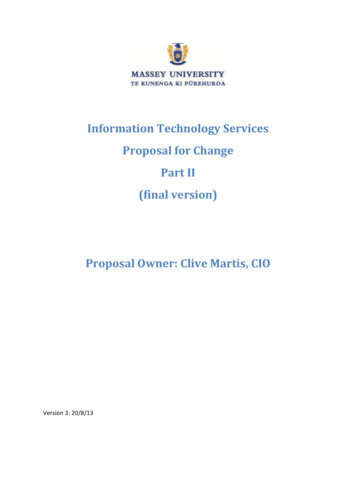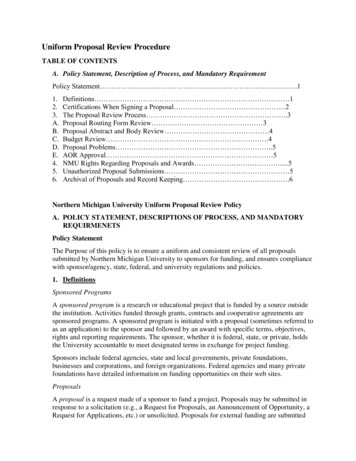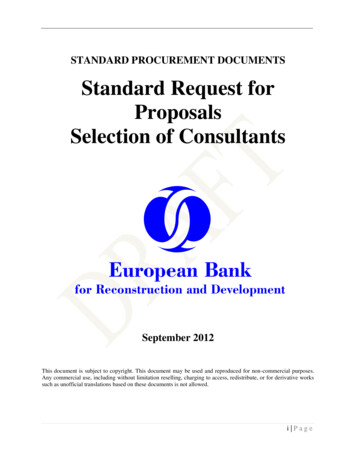
Transcription
Information Technology ServicesProposal for ChangePart II(final version)Proposal Owner: Clive Martis, CIOVersion 3: 20/8/13
Updated ITS Proposal for Change Part IIContents1.Introduction and Background . 32.Scope . 43.Proposal . 83.1. Proposed Staff Impacts . 154.Process and Timeline . 225.Employee Advice, Representation and Support . 235.1. Advice and Representation . 235.2. Support . 24Appendix A - Associate Directors and Business Administration . 25Appendix B - Planning and Transformation . 26Appendix C - Business Systems Support . 28Appendix D - Service Delivery . 31Appendix E - Proposed job profiles. 32Associate Director Planning and Transformation . 33Associate Director Business Systems Support . 37Applications Development Manager . 41Projects and Portfolio Manager. 44Head of Risk, Quality and Continuity . 47Governance, Risk, Service and Policy Analyst . 50SharePoint Development Practice Lead . 54Stakeholder Engagement Specialist . 57Stakeholder Engagement Analyst. 60Project Manager and Project Management Practice Lead . 63Technical Lead (Multimedia) . 66SharePoint Farm Administrator . 68Data Management Specialist . 71Senior Networking Engineer . 742
Updated ITS Proposal for Change Part II1.Introduction and BackgroundThe restructure of the Help Desk, Regional IT and Training in IT Services was completed in March thisyear. The new Service Delivery section of ITS is coming together well and the Help Desk has nowchanged into a Service Desk, with sufficient trained staff to work towards a “fix at first contact”percentage of 80%. The IT teams undertaking desktop support across the campuses are all underthe management of the Associate Director Service Delivery, which is helping to ensure a consistentlevel of service for all University staff. Attention is now moving to the redesign of the structure ofthe rest of IT Services to complement the changes made to front line support.In preparation for rethinking the IT Services structure, I engaged an external company, Davanti, toundertake a health check of IT Services. The report produced by Davanti in 2012 identified a numberof issues to be tackled. Some of these issues are now able to be addressed by the new ServiceDelivery section, which is working to develop a common understanding with customers of theservices and service levels they can expect. This will be backed up by the measurement andpublishing of key performance indicators.The Davanti report also outlined areas where IT Services had made particular gains, such assuccessfully managing to provide fundamental services and support, with particularly strongprogress around Massey’s core applications architecture and technology infrastructure. ITgovernance is beginning to mature and the skills, expertise, and commitment of individual peopleprovide a positive service experience to their customers.The report outlined a number of areas for improvement that are the focus of this proposal forchange. Firstly, the current structure does not make best use of resources and has enabled “silos” ofspecialisation to develop that are creating a barrier to service delivery right across the organisation.In addition, IT Services should make a separation between “business as usual”1 and newdevelopments to ensure that consistent levels of service can be applied to “business as usual” and toensure that the true cost of new developments is recognised as part of the decision making prior tocommitting to new projects. The report noted that IT Services needed to develop a closer alignmentto the business of the University.IT Services also contributed to a benchmarking exercise across Australasian Universities to measureservice quality, and the results and feedback from this exercise also indicated a number of areas forimprovement, some of which overlapped with those from the Davanti report. A particular findingfrom the benchmarking exercise was that IT Services needed to improve end to end support in orderto improve service quality.The IT Managers then met for a discussion session based on the Davanti report’s findings and theSystems Thinking Benchmarking results, organised in the World Café style to encourage interchangeof ideas. This session gave broad support to the concepts outlined in the report and provided inputto a proposed new structure for the parts of IT Services not included in the Service Delivery section.1“Business as usual” means the operational support of existing systems3
Updated ITS Proposal for Change Part IIThe new structure proposed here has the following aims: To change the “silo” effect and enable IT Services staff to gain visibility of their responsibilityto service delivery.To make a separation between “business as usual” and the planning and delivery of changedenvironments and services.To provide clear points of contact for customers and stakeholders.To enable a significantly greater strategic view within IT Services, allowing myself and theAssociate Directors to focus on planning for the future.To enhance the visibility and alignment of strategic IT planning and associated ITgovernance.To further develop the consistency of project, portfolio and dependency planning,resourcing, management, and project handover.For staff, this proposal aims to minimise the disestablishment of positions whilst providingopportunities for growth and development while focusing on outcomes as outlined above. It isevident that IT Services’ staff have a wealth of skills and a strong desire to do a good job. Myintention is that the proposed structure will provide a more effective vehicle for their hard work andwill help recognise and support individual development of skills as well as leadership capabilities.If this proposal goes ahead in its current form, there are a number of positive outcomes that I canforesee: IT Services will be able to manage the business as usual activity within clearly establishedoperational budgets, linked to the Service Catalogue Capital budgets and the associated fully costed programmes of work will be moreaccountable and manageable University staff will have clear customer contact points for new work There will be fluent delivery of new services, through agreed acceptance processes, into asupportive production environment IT Services will be better placed to manage resourcing conflicts between project schedulesand operational service level workloads Significant change to existing services will be delivered as properly resourced projects, andcommissioned (or retired) with appropriate support, budget and service agreementadjustments.Underpinning all of this, is the strong intent that ITS will provide the very best of services, tools andinfrastructure to support Massey’s students in their various learning and research environments,academics in their research, teaching and collaboration activities, and general staff in the operationof systems and services supporting the university mission.2.ScopeThe ITS staff covered by this proposal are all those in IT Services apart from the staff reporting to theAssociate Director Service Delivery. Note that a number of IT Services staff, both permanent and4
Updated ITS Proposal for Change Part IIfixed term, are involved in projects being managed outside ITS. For the purposes of this proposal,the current structure and the proposed structure are based around the permanent underlyingstructure of IT Services.Those staff currently working in projects being managed outside ITS will not experience any changeto their current work, with one exception; in this particular case, any member of staff having asubstantive “manager” position, would return to manage their team in the updated structure. Inaddition, some staff will experience minor change to their substantive position (or in the case ofthose staff appointed directly into project-related roles, changes to what would logically be their“home” position in the event of their project being put on hold).Current structure and resources:ROLEAssociate Director Service Delivery(Fixed term position)Associate Director ApplicationsAssociate Director Networking andCommunicationsAssociate Director SystemsInfrastructureBusiness ManagerSenior Project Manager - SharePointActing Development ManagerStream Team LeaderDesign and Delivery ManagerVacancy - Applications ProjectChange AdministratorManager Support ServicesVacancy – Web Services TeamLeaderBusiness Continuity and FacilitiesManagerIT Security ManagerInfrastructure Service DeliveryManagerInfrastructure Support ManagerInfrastructure DevelopmentManagerTeaching Services ManagerBusiness AdministratorDepartmental AdministratorContract and Licensing5Reporting toCIOFTE1.0 FTECIOCIO1.0 FTE1.0 FTECIO1.0 FTECIOAssociate Director ApplicationsAssociate Director ApplicationsAssociate Director ApplicationsAssociate Director ApplicationsAssociate Director Applications1.0 FTE1.0 FTE1.0 FTE1.0 FTE1.0 FTE1.0 FTEAssociate Director ApplicationsAssociate Director Applications1.0 FTE1.0 FTEAssociate Director Networking andCommunicationsAssociate Director Networking andCommunicationsAssociate Director Systems Infrastructure1.0 FTEAssociate Director Systems InfrastructureAssociate Director Systems Infrastructure1.0 FTE1.0 FTECIOBusiness ManagerBusiness ManagerBusiness Manager1.0 FTE2.0 FTE1.0 FTE1.0 FTE1.0 FTE1.0 FTE
Updated ITS Proposal for Change Part IIAdministratorProjects AdministratorSoftware Developer (fixed term)Senior Analyst/Programmer (fixedterm)Analyst ProgrammerApplication Support AnalystVacancy – Software DeveloperVacancy – .NET Architect(substantive position of ActingDevelopment Manager)Analyst/ProgrammerSoftware Developer (fixed term)Software Design ArchitectApplication Support Analyst,Analyst/Programmer,Applications Programmer,Application Support Analyst –Payroll,Support Analyst – Finance,BI Developer/AnalystSoftware Test AnalystVacancy – Software Test Analyst(temporarily filled by contractor)Senior Business AnalystSenior Business Analyst (onsecondment and backfilled by a fixedterm Senior Business Analyst)Business AnalystBusiness Analyst (fixed term)Business Analyst (fixed term,backfill)Software Test Analyst (fixed term)Business Analyst (fixed term)Senior Business Analyst (fixed term)Moodle/PHP Analyst/ProgrammerStream Support and Testing AnalystUser Support Analyst (OnlineLearning)Multimedia DeveloperWeb Analyst ProgrammerSharePoint/Application Developer,SharePoint DeveloperSharePoint Developer (fixed term)6Business ManagerActing Development ManagerActing Development Manager1.0 FTE0.8 FTE1.0 FTEActing Development ManagerActing Development ManagerActing Development ManagerActing Development Manager0.8 FTE1.0 FTE2.0 FTE1.0 FTEActing Development ManagerActing Development ManagerActing Development Manager1.0 FTE1.0 FTE1.0 FTEManager Support Services10.42 FTEDesign and Delivery ManagerDesign and Delivery Manager1.0 FTE1.0 FTEDesign and Delivery ManagerDesign and Delivery Manager3.0 FTE1.0 FTEDesign and Delivery ManagerDesign and Delivery ManagerDesign and Delivery Manager3.0 FTE1.0 FTE1.0 FTEDesign and Delivery ManagerDesign and Delivery ManagerDesign and Delivery Manager)Stream Team LeaderStream Team LeaderStream Team Leader2.0 FTE1.0 FTE1.0 FTE1.0 FTE1.0 FTE1.0 FTEVacancy – Web Services Team LeaderVacancy – Web Services Team LeaderVacancy – Web Services Team Leader1.0 FTE4.0 FTE3.0 FTEVacancy – Web Services Team Leader1.0 FTE
Updated ITS Proposal for Change Part IIInfrastructure DevelopmentEngineerData Storage EngineerSupport Analyst – Service DeliveryTechnical Database AdministratorSystems Engineer – WebArchitectureVacancy - Systems Engineer –SharePointVacancy - Systems Engineer –Business IntelligenceOperatorSystems EngineerVacancy - Systems Engineer –Unified CommunicationsInfrastructure Project ManagerProject Manager (fixed term)Infrastructure Change AdministratorSystems Engineer - TelephonyNetwork EngineerTelephony AdministratorSystems Engineer - SecurityTechnical Coordinator (Audio Visual)Technical Coordinator (VideoConferencing)Audio Visual Projects Assistant (fixedterm)Image Development Team LeaderSoftware Delivery DeveloperTOTALInfrastructure Service Delivery Manager4.0 FTEInfrastructure Service Delivery ManagerInfrastructure Service Delivery ManagerInfrastructure Service Delivery ManagerInfrastructure Service Delivery Manager1.0 FTE1.0 FTE1.0 FTE1.0 FTEInfrastructure Service Delivery Manager1.0 FTEInfrastructure Service Delivery Manager1.0 FTEInfrastructure Support ManagerInfrastructure Support ManagerInfrastructure Support Manager2.0 FTE8.0 FTE1.0 FTEInfrastructure Development ManagerInfrastructure Development ManagerInfrastructure Development ManagerAssociate Director Networking andCommunicationsAssociate Director Networking andCommunicationsAssociate Director Networking andCommunicationsIT Security ManagerTeaching Services ManagerTeaching Services Manager4.0 FTE1.0 FTE1.0 FTE1.0 FTETeaching Services Manager1.0 FTETeaching Services ManagerImage Development Team LeaderStaff costs covered by cost recoveries.72.0 FTE1.0 FTE2.0 FTE1.0 FTE1.0 FTE1.0 FTE5.0 FTE112.02 FTE
Updated ITS Proposal for Change Part IICurrent organisation chart:CIOTeachingServicesManager2 FTETechnicalCoordinatorAssociate DirectorApplicationsApplicationsProject ChangeAdministratorAudio VisualProjectsAssistantImageDevelopmentTeam Leader5 am TeamLeaderManagerSupportServicesVacancyWeb ServicesTeam LeaderAssociate DirectorSystems InfrastructureInfrastructureService DeliveryManagerSenior ProjectManager SharePointDesign andDeliveryManager3.Associate DirectorService DeliveryStructure ofService Deliveryas per earlierproposal9.6 FTEApplicationsDevelopmentTeam3 FTEStream Team16 FTEService DeliveryDesign team10.42 FTEApplicationsSupport Team9 FTESharePoint &Web ServicesTeam10 FTEInfrastructureService DeliveryTeamInfrastructureSupportManager11 FTESystemsInfrastructureSupport te DirectorNetworks andCommunicationsSystemsEngineer TelephonyBusinessManager2 FTEBusinessAdministratorDepartmentalAdministrator2 FTENetworkEngineerBusinessContinuity &FacilitiesManagerProjectsAdministratorContract andLicensingAdministratorTelephonyAdministratorIT SecurityManager2 FTESystemsEngineer Security6 FTEInfrastructureDevelopmentTeamProposalTo achieve the planned changes outlined above in section 1, I propose to restructure IT Services intothree sections: Planning and Transformation to cover new developments together with aspects ofstrategy and planning; Business Systems Support to ensure consistent provision of IT systems andapplications support and maintenance; and Service Delivery, the section recently reorganised toprovide a responsive Service Desk, clear service level management, desktop support and IT training.While this proposed change involves movement of teams into new reporting lines and workingalongside different colleagues, the aim has been to minimise disestablishments. This has beenlimited to the current permanent Associate Director positions, as the proposed structure does notmap onto the current portfolios for those positions. As outlined in Section 4, the ongoing position ofAssociate Director Service Delivery will be recruited in May 2014. The proposed structure chart forthe senior management team of IT Services is shown in Appendix A.The proposed revised structure encompasses 118 positions (117.02 FTE) of which 4 are seniormanagers, 38 are in the Planning and Transformation section and 72 are in the Business SystemsSupport section. Of these 14 are new positions, which will be covered by disestablished positions,by various vacancies that have been repurposed for this proposal or by future vacancies. All newpositions will be advertised both internally and externally, and are open to application from anystaff. The job profiles for the new positions to be recruited this year can be found in Appendix E.8
Updated ITS Proposal for Change Part IIMy aim in developing the proposed new structure has been to find the best fit role for each memberof staff, while ensuring we retain skills and experience within IT Services. For the majority of staffthis would entail changes to their reporting line and/or their job title and/or minor changes to theirjob profile. In consultation with People and Organisational Development, it has been ascertainedthat none of these proposed amendments constitute significant changes to the nature of the work.Any staff with changes to their job profile have received a copy of the amended job profile with thisproposal. The minor changes are listed in section 3.1A below.As with any reorganisation, it is anticipated the proposed job profiles will need to be refined overtime as the roles progress and the structure is embedded. There will need to be a transition periodas staff adjust to work in their new situations. For some this will be quite rapid, for others thetransition relies on the development of skills among other staff, which may take significantly longer.Finding the optimal office location for each staff member will be a further important step in thechange process, and this will be approached once the proposal is finalised. The main criteria forlocation will be that staff need to be co-located with the staff they work most closely with. Until weare able to consolidate our building workspaces, this might not mean that groups and sections arenecessarily housed together. Once the agreed new structure is in place, operational levelagreements and business rules will be set up to define how the various teams will be required towork together, to ensure that the new structure is embedded well and operates smoothly.Though not directly part of this proposal, there is parallel activity underway to establish a formalprocess within ITS, whereby it will be possible to appropriately recognise by title and remunerationthe advanced skills, capabilities and responsibilities among staff in technical roles. This supportsthose staff with a continuing focus to develop a “senior” technical status in their chosen area ofexpertise, without requiring them to feel they must choose a management track or apply for otherjobs to advance their situation. This would be accomplished through a variety of means such as goalsetting in conjunction with line management, participation in leadership and mentoringopportunities, technical excellence, qualifications attainment, broader responsibilities and continuedhigh levels of performance.In the same way, I also recognise the difficulty in recruiting staff with skills at the level we require. Ibelieve our future resourcing model will involve a concentrated mentoring, training anddevelopment approach to bring graduates and new hires quickly into well rounded and effectivesupport roles with known specialities that will help drive high performance support, while alsofreeing our senior technical staff for more challenging work. I want ITS at Massey to be an employerof choice for those developing their IT careers.General principlesManagers will be selected for their management capability as well as operating in their areas ofexpertise. They will be assisted by subject matter experts who will be involved in providing strategicdecision support to their managers and the Associate Directors. The Associate Directors willthemselves need to be very experienced generalists, capable of functioning with comprehensiveknowledge across their portfolio.9
Updated ITS Proposal for Change Part IIThough there are some exceptions, I have used these underlying principles in developing theproposed new structure for ITS. Firstly, the title Manager is generally used only for those staffreporting to Associate Directors and where there is also the responsibility for managing a group ofstaff. Within these groups, the individual teams will be led by team leaders, requiring a number ofnew team leader roles, as outlined below. Secondly, I propose to nominate various positions as“Practice Lead”, with the aim of ensuring that such technical leaders in IT Services are recognised fortheir skills, and tasked with developing good practice in their area of specialisation, ensuring thatothers working in these areas are able to improve their practice and work consistently againststandards.Managers and team leaders are responsible for allocating work to, and setting schedules for thosewithin their teams. Support requests or changes in prioritisation will be negotiated with thosesupervisors.New Team Leader rolesIt is also proposed that a number of new team leader roles will be set up on a fixed term basis, with thelength of the term to be agreed on a case-by-case basis. Suitable team leaders will be selected bymanagers from those making themselves available for the role. Should it not be possible to appoint, forwhatever reason, then the role would not be filled during this initial implementation phase. An extraresponsibility allowance would be paid for those in team leader roles, which are listed as follows: Web/SharePoint Developer & Team LeaderAnalyst/Programmer & Team LeaderSystems Engineer/Support Analyst & Team LeaderNetworking/Telephony Team LeaderBusiness Applications Support Team LeaderData, Integration & Web Support Team LeaderSoftware Tester & Team LeaderTechnical Applications Support Team LeaderAs these new roles would be fixed term, staff undertaking a team leader role would easily be able tostep back into their original role at the end of the fixed term period or earlier if it transpires thatteam leadership is not for them. Staff on fixed term contracts in these teams would be able to applyfor the team leader role if they had at least 12 months remaining on their contract. Having the rolesas fixed term would therefore over time facilitate the development of a group of staff with thepotential for moving to management positions and this will greatly assist with succession planningacross IT Services. In some cases, depending on capability and availability, the team leader fixedterm period may be extended. Fixed term team leaders would not access the private HR records andsalary information of other staff. This activity will remain within the scope of the permanentmanagers.Current team leaders (ie. those with permanent team leader positions) would be moved across tothe new structure as permanent team leaders under their current terms and conditions. However ifany of these permanent team leaders vacated their position, the position would be reviewed in thelight of this new team leadership practice.10
Updated ITS Proposal for Change Part IIBusiness Systems SupportThe proposed Business Systems Support section will ensure that business as usual proceeds with adefined number of support staff, allowing service levels to be maintained at a consistent level. Thissection will provide Level Two support and maintenance for all supported services, and will workwith vendors, developers and specialist contractors for any Level Three support and maintenancerequired.Three large groups are proposed for this section, encompassing Applications Support, InfrastructureSupport and Applications Development.The security team, the business continuity function and the newly established testing team areproposed to report to a newly established Head of Risk, Quality and Continuity position, bringing aconsistent and close management overview to these areas that do much to deliver a safe andsustainable IT operation.I propose the testing team will include those employed as software testers who would then workacross all services, to boost our generic testing capability in this area by ensuring test plans aredeveloped and adhered to for all changes, across all services. As this team is still in a formative state,with some members seconded out into other projects, there will be no leader initially appointed forthis team, with staff reporting directly to the Head of Risk, Quality and Continuity.I also propose that the Business Systems Support section should include the current Software Imageteam who are currently reporting within the Teaching Services team. Their role has expanded overthe past year to include responsibility for preparing the desktop software set for all staff computersas well as for student computing laboratories and teaching rooms, and there are furtheropportunities to develop responsibilities within this team to manage a wider set of software imagesstill. I would expect this to be worked through once the new management structure is in place. Thisteam’s work is not funded by capital projects and is cyclical in nature and I therefore consider thatthey fit most logically within the Business Systems Support section.I also propose that those Systems Engineers spending the majority of their time supporting andmaintaining corporate software packages are included in the Applications Support group as part of aTechnical Applications Support team. This would encompass software such as Exchange, Sympa andMailMarshall (email), Millennium and Dspace (Library), Active Directory, Shibboleth and FIM (accessand authentication), MyMassey (web portal), Pharos (print management), Sharepoint (collaboration)and Lync (communications) together with the Stream technical environment. Additionally this teamwould include the new role of Sharepoint Farm Administrator, providing a management andmaintenance oversight for the Sharepoint environment.It is proposed that the Technical Database Administrator would join the Applications Support groupin a Practice Lead capacity, working alongside the Applications Support Analysts, and responsible formanaging the practice of those staff with database administration access. Applications Support staffwith relevant skill and experience will operate as a virtual team, be granted appropriate access toperform database administration work, and these staff will have their job profiles amended toendorse this work. The current Applications Support Analysts and the User Support Analyst (OnlineLearning) will be split across three teams in the Applications Support group according to the day-to-11
Updated ITS Proposal for Change Part IIday work they perform. These teams are Business Applications Support, Technical ApplicationsSupport and Data, Integration and Web Support. It is proposed that the Data, Integration and WebSupport team will have one or two additional web analyst/programmers on rotation for agreedperiods from the Applications Development group, to support the placement of support activityaway from development staff, and to help transfer web support skills among those in theApplications Support Group.The Infrastructure Support group would in this proposal become part of the Business SystemsSupport section, with the Infrastructure Support Manager managing an amended team. It isproposed that the position of Infrastructure Change Administrator would be renamed as ChangeAnalyst and report to the Infrastructure Support Manager. The Systems Engineers team (other thanthose outlined above) and the Operators would remain in this group. I propose to create aNetworking / Telephony team, with a fixed-term Team Leader role, and move the TelephonyAdministrator (given the wide variety of level 2 support activities undertaken), together with thoseinvolved with network and telephony support into this team. Additionally, I propose to add a SeniorNetwork Engineer into this team, to add further depth to the technical support available across ourextensive network, and that the Systems Engineer positions in Wellington and Albany be morecorrectly titled as Systems Engineer (Networking) in recognition of their primary workload, andreport through this team also. These changes would provide a more defined focus on business asusual infrastructure support, and some flexibility for cross skilling between the systems and networkengineering staff. In the current structure both systems and network engineers are stretchedbetween support for business as usual and working on new developments. A fundamental principleof this proposal is that business as usual needs to be se
Those staff currently working in projects being managed outside ITS will not experience any change to their current work, with one exception; in this particular case, any member of staff having a . proposal Services Audio Visual Business Proposal . Business Systems Support. 13 . Updated ITS Proposal for Change Part II . 20 Business Systems .











